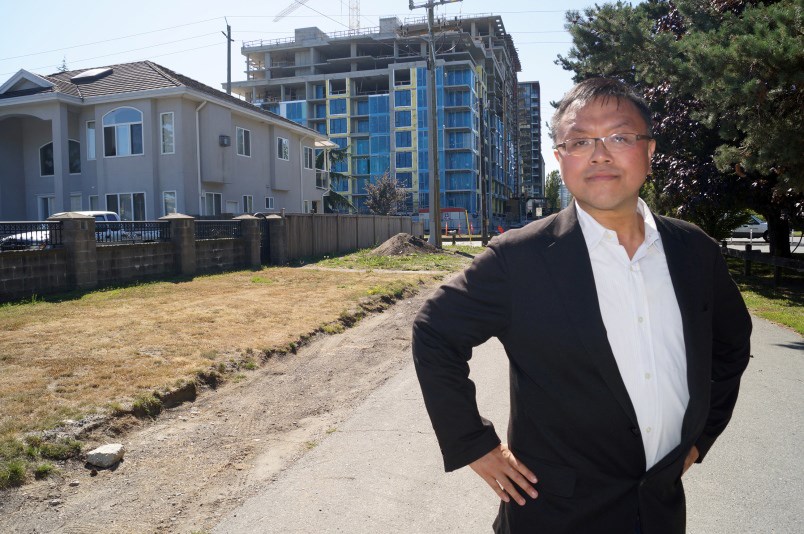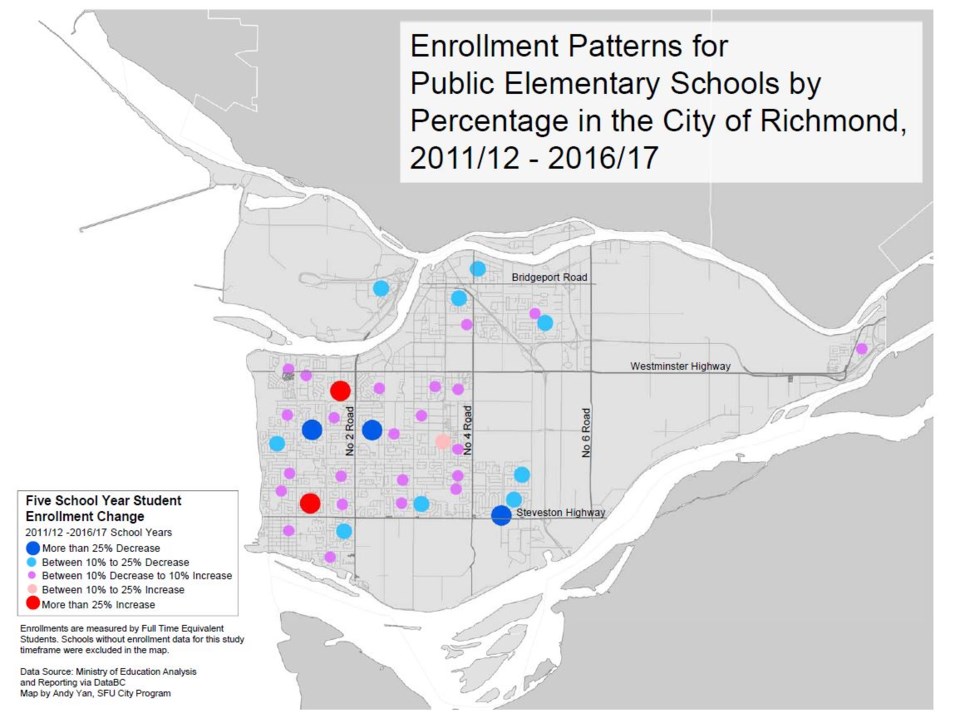Neighbourhoods once designed to raise families may soon lay in waste as Richmond’s school-age children continue to shift to the city’s centre and the outer suburbs of the Lower Mainland and beyond.
Following a regional analysis of elementary school children enrolled in the public education system, urban planner and director of Simon Fraser University’s City Program Andy Yan says residents and public officials should be concerned about a paradigm shift in the city’s livability.
“Wow, what is happening to Richmond?” was the first thing that came to mind, he said, when he saw Richmond had lost 401 such students — a 3.5 per cent decline — over the past five years. Vancouver was the only other school district that saw a decline (0.4 per cent) while the likes of Langley and Surrey saw big boosts, at 10.9 and eight per cent. Overall, the region’s elementary school population grew by 4.4 per cent.
Yan suggests the city, particularly in the west and south neighbourhoods, is losing (or has lost) its status as a family-friendly place. This is antithetical to the built form of neighbourhoods, he said.
“The suburbs were where you go to breed. You have a family of kids and that’s the lifecycle. That’s the traditional view of urban growth,” said Yan.
When farmland was subdivided in the ‘60s, Richmond was built for families, he noted.
“The public elementary school was to be one of the keystones in neighbourhoods. Municipalities have taken that as a planning principle — the importance of having an elementary school you can walk to,” he said.
Yan notes other demographics are at play, such as couples not having as many children as they used to and incomes stagnating.
But Yan points his finger squarely at one major underlying factor: the cost of housing.

“It comes down to affordability for families with children,” said Yan.
Over five years, there has been a nine per cent decline in total enrolment (high school and elementary) at Richmond School District, where officials expect three more years of decline, resulting in a total decline of 11.5 per cent since 2012, leaving 19,765 students.
Some of the decline could be explained by more students attending private schools, Yan noted. But over the past 20 years, according to census data, Richmond’s child population (under the age of 15) has decreased by 695, to 27,240 total. Their share of the total population has declined from 18.8 per cent to 13.7 per cent in that time.
School trustee Ken Hamaguchi, 58, says the anecdotal evidence is apparent, having grown up in Richmond and raised two children himself.
“I grew up in the Seafair area and I go back and visit. All there are is big giant houses. I don’t know many families who can afford them,” said Hamaguchi.
“You can’t afford to buy a house there and even rental is becoming a challenge. I have friends who have left Richmond because it’s too expensive. It’s a real thing what’s happening,” said Hamaguchi.
“Until that changes, chances are you won’t see a change in the rate of decline,” he added.
Coun. Linda McPhail, a mother of three adult children raised in a single-family neighbourhood, said affordability is beginning to show its cracks on the functionality of the city.
“It’s not a new trend, but we’re starting to see the impact on the community more and more,” said McPhail, a former school trustee.
She and trustee Donna Sargent are on a City of Richmond-district liaison committee, which is to discuss interrelated matters, including how best to plan schools and housing for families.
“I don’t want a city with no young people in it. So we have to plan together to make sure the city is livable, and that means young people and old people cohabitating together,” said Sargent, who also raised children (now adults) in a single-family neighbourhood.
Officials note that there are few new and affordable housing options for families outside the City Centre, which has seen growth in children. But compounding the problem there is the fact numerous condo developments were built before the district and City of Richmond had a concrete plan for a new school.
“It’s bad planning. You need to serve families. It’s the need for social and cultural infrastructure. It isn’t only about growth in terms of residential units. You need to support those residential units,” said Yan.
Two new, central elementary schools are required and nearby schools require expansions. Meanwhile, the district has put a school closure process, for schools outside the centre, on the back burner.
Sargent and McPhail both suggest looking at new housing options such as coach houses, secondary suites and developing arterial roads for multi-family units.
“I think we’ll always have single-family neighbourhoods. That would be my hope,” said McPhail.
But she acknowledges solutions such as small lot subdivisions (turning one home into two or three narrow ones) are not likely to solve anything under the present market conditions.
“A few years ago, we looked at small houses on Moncton (Street). At the time, we were thinking they’d sell for $800,000 to 900,000. Now they’re selling for $1.5 million. It’s frightening when you see that,” she said.
Like so many other boomers, McPhail, Sargent and Hamaguchi are empty nesters with adult children.
Yan said empty nesters are one factor that is making family-friendly housing unavailable. Another factor is speculation, and in Richmond there are just over 4,000 empty housing units.
Yan’s past data analyses have shown the region’s housing has become highly sought after by global speculators, particularly from China. On a per capita basis, Richmond is the region’s primary target for foreign money entering housing and shutting out local income earners hoping to enter the market.
Yan says building family-friendly housing is necessary but he also suggests housing demand needs to be addressed if Richmond is going to curb its livability problems.
“How do you influence global capital?”
“Who you are trying to house and who you are trying to nurture?”
“Who are you building for?”
“What happens when many of these units are up for speculation?”
Yan suggests the time is nigh to implement public policy that commits to family-oriented housing.
McPhail said the city is looking at incentives to build rental housing and also increase the number of two- and three-bedroom units.




